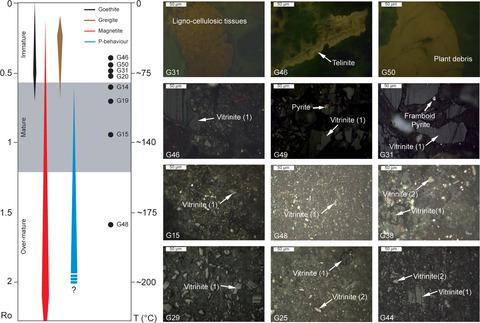当前位置:
X-MOL 学术
›
Basin Res.
›
论文详情
Our official English website, www.x-mol.net, welcomes your feedback! (Note: you will need to create a separate account there.)
The thermal maturity of sedimentary basins as revealed by magnetic mineralogy
Basin Research ( IF 3.2 ) Pub Date : 2020-02-26 , DOI: 10.1111/bre.12439 Mansour M. Abdelmalak 1, 2 , Stéphane Polteau 3, 4
Basin Research ( IF 3.2 ) Pub Date : 2020-02-26 , DOI: 10.1111/bre.12439 Mansour M. Abdelmalak 1, 2 , Stéphane Polteau 3, 4
Affiliation

|
[Abstract The thermal evolution of sedimentary basins is usually constrained by maturity data, which is interpreted from Rock‐Eval pyrolysis and vitrinite reflectance analytical results on field or boreholes samples. However, some thermal evolution models may be inaccurate due to the use of elevated maturities measured in samples collected within an undetected metamorphic contact aureole surrounding a magmatic intrusion. In this context, we investigate the maturity and magnetic mineralogy of 16 claystone samples from Disko‐Svartenhuk Basin, part of the SE Baffin Bay volcanic margin. Samples were collected within thermal contact metamorphic aureoles near magma intrusions, as well as equivalent reference samples not affected by intrusions. Rock‐Eval pyrolysis (Tmax), and vitrinite reflectance (Ro) analysis were performed to assess the thermal maturity, which lies in the oil window when 435°C ≤ Tmax ≤ 470°C and 0.6%–0.7% ≤ Ro ≤ 1.3%. In addition, we performed low‐ ( 300K) investigations of isothermal remanent magnetization to assess the magnetic mineralogy of the selected samples. The maturity results (0.37% ≤ Ro ≤ 2%, 22°C ≤ Tmax ≤ 604°C) show a predominance of immature to early mature Type III organic matter, but do not reliably identify the contact aureole when compared to the reference samples. The magnetic assemblage of the immature samples consists of iron sulphide (greigite), goethite and oxidized or non‐stoichiometric magnetite. The magnetic assemblage of the early mature to mature samples consists of stoichiometric magnetite and fine‐grained pyrrhotite (<1 μm). These results document the disappearance of the iron sulphide (greigite) and increase in content of magnetite during normal burial. On the other hand, magnetite is interpreted to be the dominant magnetic mineral inside the contact aureole surrounding dyke/sill intrusions where palaeotemperatures indicate mature to over‐mature state. Interestingly, the iron sulphide (greigite) is still detected in the contact aureole where palaeotemperatures exceeded 130°C. Therefore, the magnetic mineralogy is a sensitive method that can characterize normal burial history, as well as identify hidden metamorphic contact aureoles where the iron sulphide greigite is present at temperatures beyond its stability field., Model showing the formation of magnetic mineral as a function of organic matter maturity and temperature. The maturity of the different samples is well constrained by Rock‐Eval pyrolysis and vitrinite reflectance. ]
中文翻译:

磁性矿物学揭示的沉积盆地热成熟度
[摘要] 沉积盆地的热演化通常受到成熟度数据的约束,成熟度数据是从野外或钻孔样品的 Rock-Eval 热解和镜质体反射分析结果解释的。然而,一些热演化模型可能不准确,因为使用了在岩浆侵入周围未检测到的变质接触光环内收集的样品中测量的成熟度升高。在此背景下,我们调查了来自巴芬湾东南部火山边缘的 Disko-Svartenhuk 盆地的 16 个粘土岩样品的成熟度和磁性矿物学。在岩浆侵入附近的热接触变质光环内收集样品,以及不受侵入影响的等效参考样品。Rock-Eval 热解 (Tmax),进行镜质体反射率 (Ro) 分析以评估热成熟度,当 435°C ≤ Tmax ≤ 470°C 和 0.6%–0.7% ≤ Ro ≤ 1.3% 时,热成熟度位于油窗口。此外,我们对等温剩磁进行了低 (300K) 研究,以评估所选样品的磁性矿物学。成熟度结果(0.37% ≤ Ro ≤ 2%,22°C ≤ Tmax ≤ 604°C)显示未成熟到早熟的 III 型有机质占优势,但与参考样品相比,不能可靠地识别接触光环。未成熟样品的磁性组合由硫化铁(灰色铁矿)、针铁矿和氧化或非化学计量磁铁矿组成。早期成熟到成熟样品的磁性组合由化学计量磁铁矿和细粒磁黄铁矿(<1 μm)组成。这些结果记录了在正常埋藏过程中硫化铁(灰辉石)的消失和磁铁矿含量的增加。另一方面,磁铁矿被解释为围绕岩脉/窗台侵入体的接触光环内的主要磁性矿物,其中古温度表明成熟到过成熟状态。有趣的是,在古温度超过 130°C 的接触光环中仍能检测到硫化铁(greigite)。因此,磁性矿物学是一种敏感的方法,可以表征正常的埋藏历史,以及识别隐藏的变质接触光环,其中硫化铁灰岩在其稳定场之外的温度下存在。显示磁性矿物形成的模型作为有机质成熟度和温度。不同样品的成熟度受到 Rock-Eval 热解和镜质体反射率的很好的限制。]
更新日期:2020-02-26
中文翻译:

磁性矿物学揭示的沉积盆地热成熟度
[摘要] 沉积盆地的热演化通常受到成熟度数据的约束,成熟度数据是从野外或钻孔样品的 Rock-Eval 热解和镜质体反射分析结果解释的。然而,一些热演化模型可能不准确,因为使用了在岩浆侵入周围未检测到的变质接触光环内收集的样品中测量的成熟度升高。在此背景下,我们调查了来自巴芬湾东南部火山边缘的 Disko-Svartenhuk 盆地的 16 个粘土岩样品的成熟度和磁性矿物学。在岩浆侵入附近的热接触变质光环内收集样品,以及不受侵入影响的等效参考样品。Rock-Eval 热解 (Tmax),进行镜质体反射率 (Ro) 分析以评估热成熟度,当 435°C ≤ Tmax ≤ 470°C 和 0.6%–0.7% ≤ Ro ≤ 1.3% 时,热成熟度位于油窗口。此外,我们对等温剩磁进行了低 (300K) 研究,以评估所选样品的磁性矿物学。成熟度结果(0.37% ≤ Ro ≤ 2%,22°C ≤ Tmax ≤ 604°C)显示未成熟到早熟的 III 型有机质占优势,但与参考样品相比,不能可靠地识别接触光环。未成熟样品的磁性组合由硫化铁(灰色铁矿)、针铁矿和氧化或非化学计量磁铁矿组成。早期成熟到成熟样品的磁性组合由化学计量磁铁矿和细粒磁黄铁矿(<1 μm)组成。这些结果记录了在正常埋藏过程中硫化铁(灰辉石)的消失和磁铁矿含量的增加。另一方面,磁铁矿被解释为围绕岩脉/窗台侵入体的接触光环内的主要磁性矿物,其中古温度表明成熟到过成熟状态。有趣的是,在古温度超过 130°C 的接触光环中仍能检测到硫化铁(greigite)。因此,磁性矿物学是一种敏感的方法,可以表征正常的埋藏历史,以及识别隐藏的变质接触光环,其中硫化铁灰岩在其稳定场之外的温度下存在。显示磁性矿物形成的模型作为有机质成熟度和温度。不同样品的成熟度受到 Rock-Eval 热解和镜质体反射率的很好的限制。]



























 京公网安备 11010802027423号
京公网安备 11010802027423号